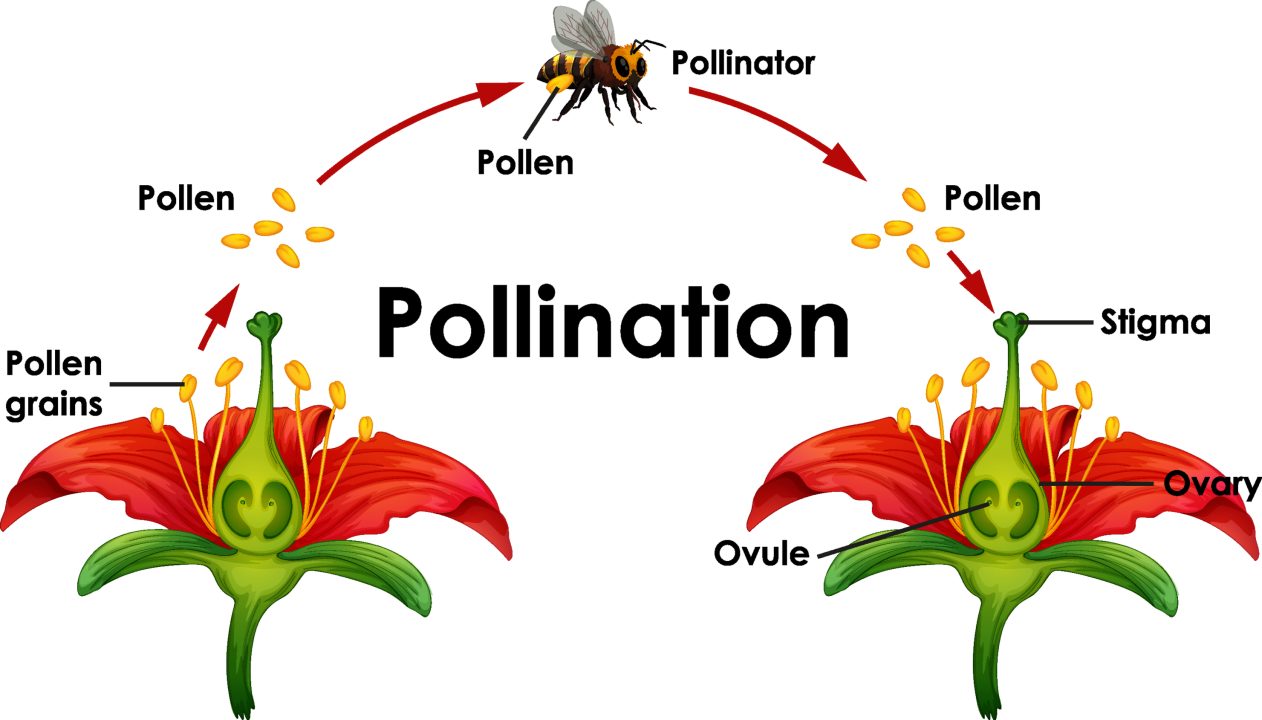Sexual and Asexual Reproduction in Plants
Modes Of Reproduction in Plants
- There are several ways by which plants produce their offspring. These are categorised into two types: (i) asexual, and (ii) sexual
- In asexual reproduction plants can give rise to new plants without seeds, whereas in sexual reproduction, new plants are obtained from seeds.
Asexual Reproduction in Plants
Asexual reproduction occurs through:
- Vegetative Propagation,
- Budding,
- Fragmentation and
- Spore formation.
Vegetative Propagation
- Most plants have roots, stems and leaves. These are called the vegetative parts of a plant.
- Vegetative Propagation is a type of asexual reproduction in which new plants are produced from roots, stems, leaves and buds. Since reproduction is through the vegetative parts of the plant, it is known as vegetative propagation.
- Bryophyllum (sprout leaf plant) has buds in the margins of leaves. If a leaf of this plant falls on a moist soil, each bud can give rise to a new plant.

Bryophyllum (sprout leaf plant)
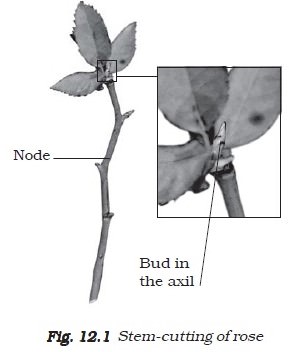
- The roots of some plants can also give rise to new plants. Sweet potato and dahlia are examples.
- Plants such as cacti produce new plants when their parts get detached from the main plant body. Each detached part can grow into a new plant.
- Plants produced by vegetative propagation take less time to grow and bear flowers and fruits earlier than those produced from seeds.
- The new plants are exact copies of the parent plant, as they are produced from a single parent.
Budding
- Yeast is a single-celled organism. The small bulb-like projection coming out from the yeast cell is called a bud.
- The bud gradually grows and gets detached from the parent cell and forms a new yeast cell.
- The new yeast cell grows, matures and produces more yeast cells. If this process continues, a large number of yeast cells are produced in a short time.
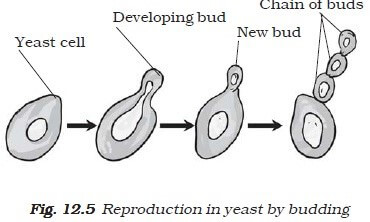
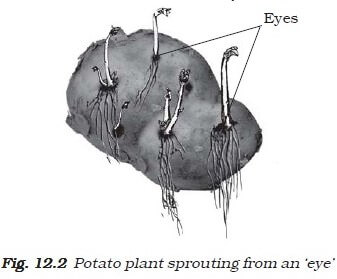
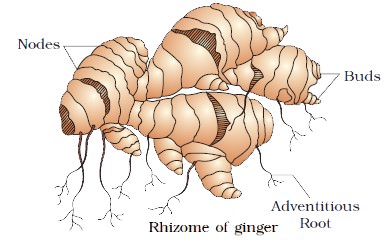
Fragmentation
- When water and nutrients are available algae grow and multiply rapidly by fragmentation.
- An alga breaks up into two or more fragments. These fragments or pieces grow into new individuals. This process continues and they cover a large area in a short period of time.
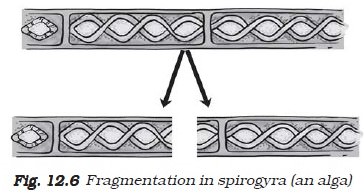
Spore formation
- Fungi on a bread piece grow from spores which are present in the air. When spores are released they keep floating in the air.
- The spores are asexual reproductive bodies. As they are very light, they can cover long distances.
- Each spore is covered by a hard protective coat to withstand unfavorable conditions such as high temperature and low humidity. So they can survive for a long time.
- Under favourable conditions, a spore germinates and develops into a new individual.
- Plants such as moss and ferns also reproduce by means of spores.
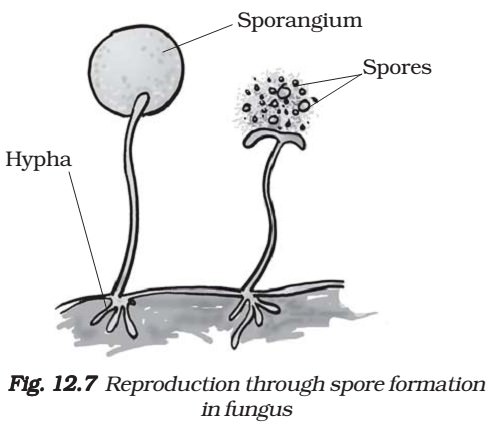
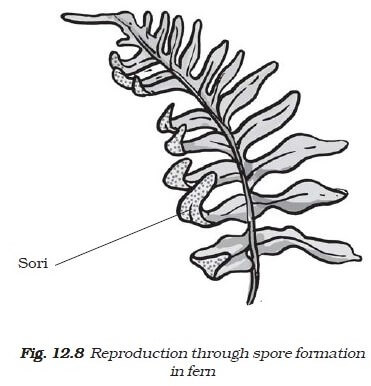
Sexual Reproduction in Plants – Unisexual and Bisexual
- The flowers are the reproductive parts of a plant. The stamens are the male reproductive part and the pistil is the female reproductive part.
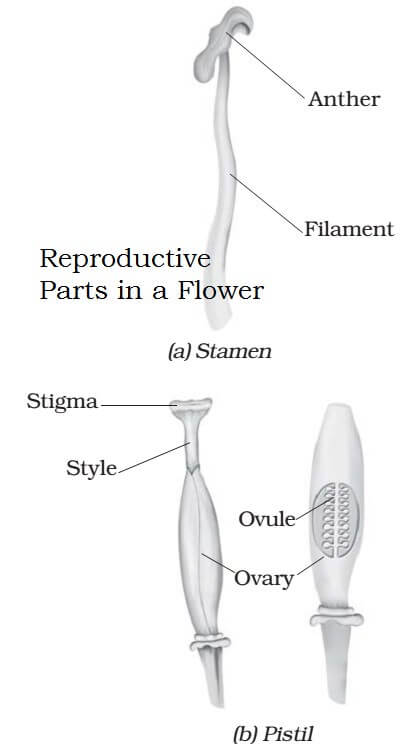
- The flowers which contain either only the pistil or only the stamens are called unisexual flowers. The flowers which contain both stamens and pistil are called bisexual flowers.
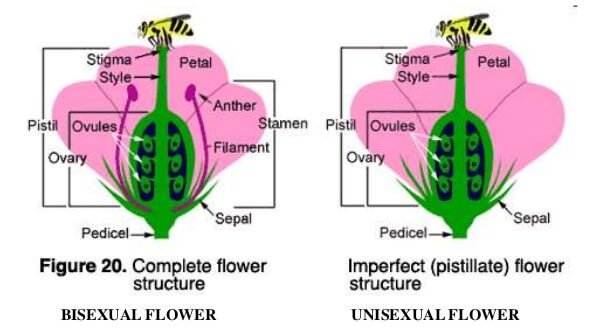
- Corn, papaya and cucumber produce unisexual flowers, whereas mustard, rose and petunia have bisexual flowers.
- Both the male and the female unisexual flowers may be present in the same plant or in different plants.
- Anther contains pollen grains which produce male gametes. A pistil consists of stigma, style and ovary. The ovary contains one or more ovules. The female gamete or the egg is formed in an ovule. In sexual reproduction a male and a female gamete fuse to form a zygote.
Pollination
- Generally pollen grains have a tough protective coat which prevents them from drying up. Since pollen grains are light, they can be carried by wind or water. Insects visit flowers and carry away pollen on their bodies.
- Some of the pollen lands on the stigma of a flower of the same kind. The transfer of pollen from the anther to the stigma of a flower is called pollination.
- If the pollen lands on the stigma of the same flower it is called self-pollination. When the pollen of a flower lands on the stigma of another flower of the same plant, or that of a different plant of the same kind, it is called cross-pollination.
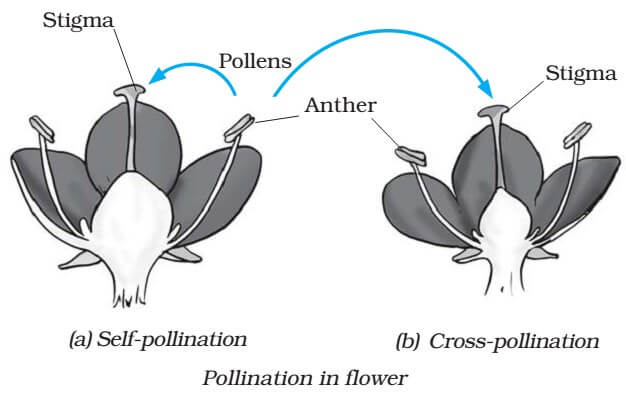
Self Pollination vs. Cross Pollination
|
Self-Pollination |
Cross-Pollination |
| 1. Pollen grains are transferred to the stigma of the same flower.2. Occurs in bisexual plants having anther and stigma maturing at same time.
3. It takes place in plants like wheat, peas etc. |
1. Pollen grains are carried to stigma of another flower.2. Occurs in bisexual flowers having anther and stigma maturing at different times.
3. It takes place in plants like lady- finger, tomato, brinjal etc. |
Fertilisation
- The cell which results after fusion of the gametes is called a zygote. The process of fusion of male and female gametes (to form a zygote) is called fertilization. The zygote develops into an embryo.
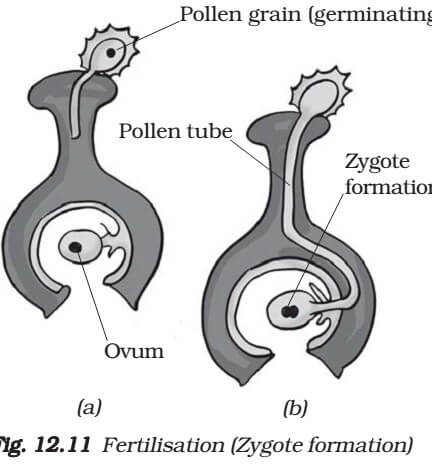
Fruits and seed formation
- After fertilization, the ovary grows into a fruit and other parts of the flower fall off. The fruit is the ripened ovary.
- The seeds develop from the ovules. The seed contains an embryo enclosed in a protective seed coat. Some fruits are fleshy and juicy such as mango, apple and orange. Some fruits are hard like almonds and walnuts.
Seed dispersal
- Some seeds are dispersed by animals, especially spiny seeds with hooks which get attached to the bodies of animals and are carried to distant places. Examples are Xanthium and Urena.
- Some seeds are dispersed when the fruits burst with sudden jerks. The seeds are scattered far from the parent plant. This happens in the case of Castor and Balsam.
Asexual reproduction vs Sexual reproduction
|
Asexual reproduction |
Sexual reproduction |
| a) Only one parent plant is involved. | a) Both male and female parents are involved. |
| b) Occurs in unisexual plants. | b) Occurs in bisexual plants. |
| c) Occurs in lower plants. | c) Occurs in higher plants. |
| d) Reproductive organs are not present. | d) Fully developed reproductive parts are present |
| e) In most of the methods the original parent disappears. | e) Original parents remain alive after process of reproduction. |
| f) Process like gamete formation or fertilization is not seen. | f) Fertilization of gametes give rises to zygote. |
| g) Characteristics of only one parent is inherited. | g) Characteristics of both parents are inherited. |
| h) No need of seeds. | h) Seeds are used to get new plants from a flower |





